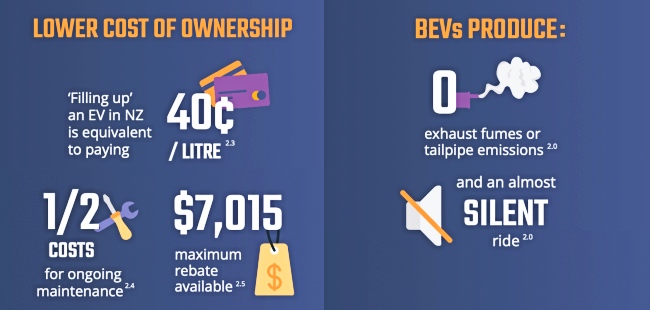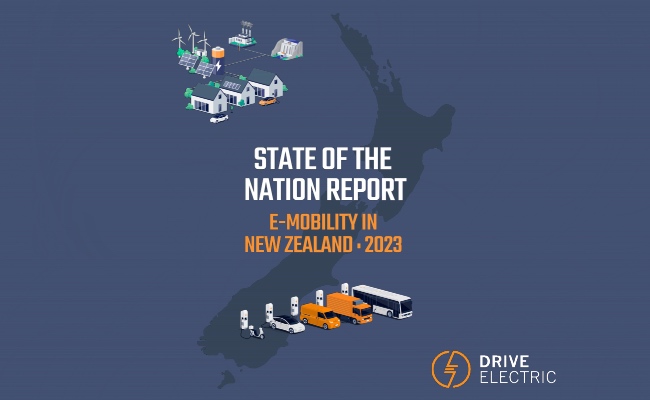Drive Electric’s State of the Nation Report on E-Mobility in NZ 2023 and the push towards transport decarbonisation is a big read.
At 78 pages it’s chock full of interesting stats and information. If you’re interested in the drive towards transport decarbonisation and want some bedtime reading, this report will school you up. Here’s the download link:
https://driveelectric.org.nz/state-of-the-nation-report/
If 78 pages is a bit much for your bedtime reading, we’ve reprinted the executive summary below.
Drive Electric is New Zealand’s leading apolitical not-for-profit organisation advocating for EV uptake & transport decarbonisation. Driveline is an “Essential Member”.
For current info on the latest EV’s, charging capacities, etc in one easy-to-access resource, Drive Electric is a great first port of call: https://driveelectric.org.nz/
Pushing For Transport Decarbonisation
Here’s the executive summary so you can school yourself on transport decarbonisation in only 2.6% of the time it would take you to read the whole report!
• • •
State of the Nation Report on E-Mobility: Executive Summary
New Zealand is on the threshold of a transformation that presents fantastic opportunities and unique challenges.
As key automotive markets and major car manufacturers commit to electric vehicles, and governments align on the efforts to mitigate climate change, we have the chance to position ourselves at the forefront of the electric vehicle movement and create a better, cleaner transport future for our country. As electric vehicles and other forms of e-mobility get cheaper this will only accelerate uptake of this form of transportation.
Decarbonising our transport system will be crucial in meeting our climate obligations. A myriad of other advantages also come with the transition to electric vehicles.
Transport accounts for 18% of our nation’s emissions, but the solution exists to decarbonise – mainly through electrification. Make no mistake, it is not clear that electric vehicles will come to dominate ICE vehicles by 2030. While EVs produce lower life cycle emissions regardless of where in the world they are driven, New Zealand’s high proportion of renewable electricity grid maximises their emissions reduction potential. An electrified transport system also reduces New Zealand’s exposure to the price of fossil fuels; will reduce household spending on transport and energy; and will reduce health impacts of air pollution.
While e-mobility is fast becoming dominant, we must be alert to technological advancements and how these will provide new opportunities. Marine, aviation and heavy transport may all lend themselves to technologies like hydrogen or cleaner forms of fuel.
The nature of New Zealand’s vehicle market amplifies the urgency to transition to electric sooner rather than later.
We are a small, right-hand drive market, with a high rate of vehicle ownership and a relatively old fleet. A high-emission vehicle entering New Zealand today will continue to impact our fleet for nearly two decades.
While recent sales figures, the sentiments of consumers and businesses, and the success of the Clean Car Discount bode well for uptake in the coming years, EVs currently account for a small part ~(2%) of our car fleet.
Embracing innovation and moving swiftly to accommodate EV uptake across all modes of transport in the 2020s will help to set New Zealand up for success in the effort to achieve net zero emissions by 2050.
This transition to e-mobility is about more than cars.
We advocate for electrification of the transport sector as a whole because realising the benefits of decarbonising transport will require more than simply swapping all the cars in New Zealand for EVs.
New Zealanders have a propensity for short car trips. A better transport sector would also see increased uptake of electric micro-mobility, ride-sharing and mobility-as-a-service models along with a lower-emission, more efficient public transport system.
Low availability and high costs of suitable light or heavy commercial transport options are hindering electric vehicle uptake in those segments. Our utes, vans and trucks tend to be higher-emitting, and driven much more regularly, so addressing adoption barriers for these vehicles will be crucial in the coming years.
Besides our road vehicles, electric marine transport and aviation technologies are still in their infancy, but have shown great promise for the coming decades. While it’s important to have the right settings in place to enable those sectors to progress, the shorter-term wins for New Zealand are to be had with road transport.
The main challenge that sits across electrification of transport is charging.
Charging readiness can make or break a successful transition to electric vehicles, and is an area in which New Zealand has some catching up to do. While the majority of electric vehicle charging is done at home, our public network needs to become more robust and more fit-for-purpose, especially as more commercial electric vehicles (both light and heavy) enter the fleet. When it comes to home charging, widespread adoption of smart chargers will be key to managing demand in future.
New Zealand’s energy sector is already well-positioned to accommodate the expected 20% increase in electricity demand from light electric vehicle uptake. Our electricity generators, distributors and retailers, along with our public charge point operators and home charging installers, all need to work to ensure that our nationwide charging infrastructure can act as an enabler of, rather than a barrier to accelerated EV adoption.
New Zealand is heading in the right direction with policy, but we must maintain momentum.
We are now armed with the learnings of other countries who have successfully implemented policy and market settings to enable successful EV uptake. New Zealand has made a number of important strides with policies such as:
- The Clean Car Programme
- The Low Emissions Transport Fund
- FBT exemptions for e-bikes and e-scooters
- Funding programmes for electric buses and trucks
It is essential that policy that works is maintained to continue the transition to e-mobility. The Clean Car Programme has been particularly successful in driving EV uptake and cleaning up emissions from the fleet.
However, much more needs to be done through the implementation of the forthcoming National EV Charging Strategy. It is likely that hundreds of millions will need to be invested in charging infrastructure, both public and private, before the end of the decade. Well targeted public investment can catalyse private sector investment many times over in the short term, by overcoming barriers. Longer term, the regulatory settings need to be right to enable electricity network business to support the connections required by decarbonisation. We also need to ensure there is a workforce strategy to service the growing e-mobility industry and associated infrastructure.
Through the implementation of smart policies, collaboration between key stakeholders, and innovative solutions, New Zealand has the opportunity to lead the charge towards a cleaner, more sustainable transportation system. Electric transport will transform how we move around our country, and it’s up to our consumers, businesses and policy makers to affect the kind of change that sets New Zealand up for success.
The time for action is now, and the potential rewards for our people, environment and our economy are immense.
• • •
Download the full report here: https://driveelectric.org.nz/state-of-the-nation-report/

BYD Atto 3 EVGet into a brand new BYD Atto 3 Standard Range at a super discounted monthly rate before the Clean Car Discount is scrapped!
• • • Get in touch…
|
